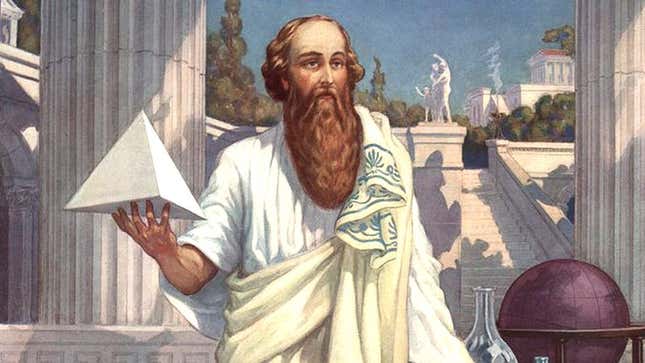
CAMBRIDGE, MA—A trove of recently unearthed documents dating back to the sixth century B.C. has revealed that the ancient Greek philosopher and mathematician Pythagoras wrote dozens of elaborate, unhinged conspiracy theorems pertaining to triangles, researchers announced Wednesday.
Upon examining a cache of papyrus scrolls found while excavating a site near the modern Italian city of Crotone, a team of historians and classical scholars at Harvard University discovered previously unknown writings by Pythagoras and others that suggest the philosopher was obsessed with proving triangles played a powerful but highly secretive role in the world he inhabited, controlling nearly every aspect of life.
“These conspiracy theorems shed new light on this historic figure, who was apparently suspicious of the fact that all triangles have interior angles adding up to 180 degrees, believing this was evidence that they were united in hiding some sort of covert agenda,” said Professor Janet Boisvert, who found among the artifacts an alternative version of the Pythagorean theorem in which Pythagoras concluded that the square of the hypotenuse of a right triangle was equal to the sum of “all the lies embodied by these cursed triangles!” “One scroll is 35 feet long and contains nothing but a rambling series of postulates attempting to demonstrate the existence of a triangle with three obtuse angles that he thought was being kept under wraps by the government.”
“Pythagoras also stayed up every night for two years working on formulas he believed would prove the Great Pyramid at Giza was a hoax perpetrated by pro-triangle propagandists,” she added.
According to Boisvert, Pythagoras’ fixation on conspiracy theorems was described in the written accounts of his students, who recalled visiting his private study and finding the walls, the tables, and nearly every available surface covered in intricate equations and charts depicting hundreds of scalene, isosceles, and equilateral triangles. One student noted that Pythagoras always seemed worried by the sheer number of triangles he saw around him, and he became extremely distraught one day upon realizing that quadrilaterals, which he had until then considered innocuous, were in fact nothing more than two triangles combined.
This paranoia is further corroborated by the diary entry of a goatherd who described an elderly mathematician wandering the streets of Metapontum and warning complete strangers about the sails of ships, the shapes of their own noses, and the encroaching power of the trigonocracy.
“We are now able to conclusively identify Pythagoras as the unnamed figure in the Histories of Herodotus who storms into a polis council meeting waving pages scrawled with formulas and screaming, ‘Triangles are all around us, hidden in every shape, and I have the proofs!’ before being escorted out,” Boisvert said. “He continued to demand the truth from local magistrates, having hypothesized that triangles had a fourth, invisible side that those in power didn’t want him to know about.”
“It’s likely that by this point, his obsession with conspiracy theorems had begun to take a toll on his home life,” she continued. “We know an increasingly isolated Pythagoras was left by his wife and four children around 515 B.C., shortly after he accused they themselves of being triangles.”
Documents indicate Pythagoras went on to live a hermetic existence in the foothills of Mount Parnassus, until the realization that even the mountain itself had a triangular shape eventually drove him to suicide.